be quiet! Pure Power 9 600W PSU Review
be quiet! released the updated Pure Power 9 series that consists of four semi-modular models with capacities ranging from 400W to 700W. Today, we're looking at the 600W implementation to see where it stands in the competitive mainstream market.
Why you can trust Tom's Hardware
A Look Inside And Component Analysis
Parts Description
Before proceeding with this page, we strongly encourage you to a look at our PSUs 101 article, which provides valuable information about PSUs and their operation, allowing you to better understand the components we're about to discuss. Our main tools for disassembling PSUs are a Thermaltronics soldering and rework station, and a Hakko 808 desoldering gun.
| Primary Side | |
|---|---|
| Transient Filter | 4x Y caps, 2x X caps, 3x CM chokes, 1x GTD |
| Inrush Protection | - |
| Bridge Rectifier(s) | 1x |
| APFC MOSFETs | 2x JCS18N50FH (500V, 11A @ 100 °C, 0.27 ohm) |
| APFC Boost Diode | 1x STMicroelectronics STTH8R06FP (600V, 8A @ 85 °C) |
| Hold-up Cap(s) | 1x Teapo (420V, 330uF, 2000h @ 85 °C, LH) |
| Primary Switchers | Main FET: 1x Infineon SPA11N80C3 (800V, 7.1A @ 100 °C, 0.45 ohm) Reset FET: CEP03N8 (800V, 2A @ 100 °C, 4.8 ohm) |
| Combo APFC/PWM Controller | FSP6600 |
| Topology | Primary side: Active Clamp Reset Forward (ACRF) Secondary side: Synchronous Rectification |
| Secondary Side | |
| +12V MOSFETs | 2x FETs |
| 5V & 3.3V | 4x Infineon IPD060N03L G (30V, 50A @ 100 °C, 6 mOhm) |
| Synchronous Controller | FSP6601 |
| Filtering Capacitors | Electrolytics: Teapo (2000h~3000h @ 105 °C, SC) Polymer: CapXon (modular board) |
| Supervisor IC | WT7527 (PG, OVP, UVP, OCP, SCP) |
| Fan Model | BQ QF1-12025-MS (120mm, 12V, 0.30A, 52 CFM, 1800 RPM, Sleeve Bearing) |
| 5VSB Circuit | |
| Rectifier | 1x CEF02N7G (700V, 1.3A @ 100 °C, 6.75 Ohm) |





The Pure Power 9 line is actually based on the FSP Raider platform, a budget version of the FSP Aurum design. The topology used in this unit is referred to as Active Clamp Reset Forward (ACRF), which offers high efficiency and lower production cost since it doesn't need extra components like an LLC resonant converter. In low-capacity ACRF designs, two FETs are used. One of them is the main switcher (Q1) while the other one is the reset switch (Q2). It's responsible for disconnecting the clamp capacitor while Q1 is active. Power is transferred from the primary side to the secondary one only when Q2 is open. ACRF's strongest advantage is the almost lossless switching of Q1; while it's off, the drain voltage is very low.
When Q1 is active, voltage is applied to T1, meaning that power is transferred from the primary side to the secondary side. When Q2 (also called the auxiliary FET) is active, clamp voltage is applied to T1. The larger the clamp capacitor (C1), the lower the ripple voltage. However, a higher-capacity C1 also slows transient response. So striking the right balance is of crucial importance in an ACRF design.
On the secondary side, a synchronous design is used for rectifying the +12V rail, while there seems to be a kind of group regulation scheme for the minor rails (even though be quiet! claims they're independently regulated). To be more specific, during our tests we noticed a link between the +12V and 5V rails; only the 3.3V rail is regulated on its own. This means that under highly unbalanced loads between the +12V and 5V rails, performance is really bad.





The first part of the transient filter starts at the AC receptacle and includes two Y caps. As expected, it continues on the main PCB with two more Y caps, a pair of X caps and three CM chokes. As mentioned previously, a gas discharge tube is used instead of a metal oxide varistor. We'd actually prefer if be quiet! used an MOV instead, since it has a faster response and doesn't short circuit the input in case of a surge.


The single bridge rectifier is installed on a dedicated heat sink with its markings hidden from view.
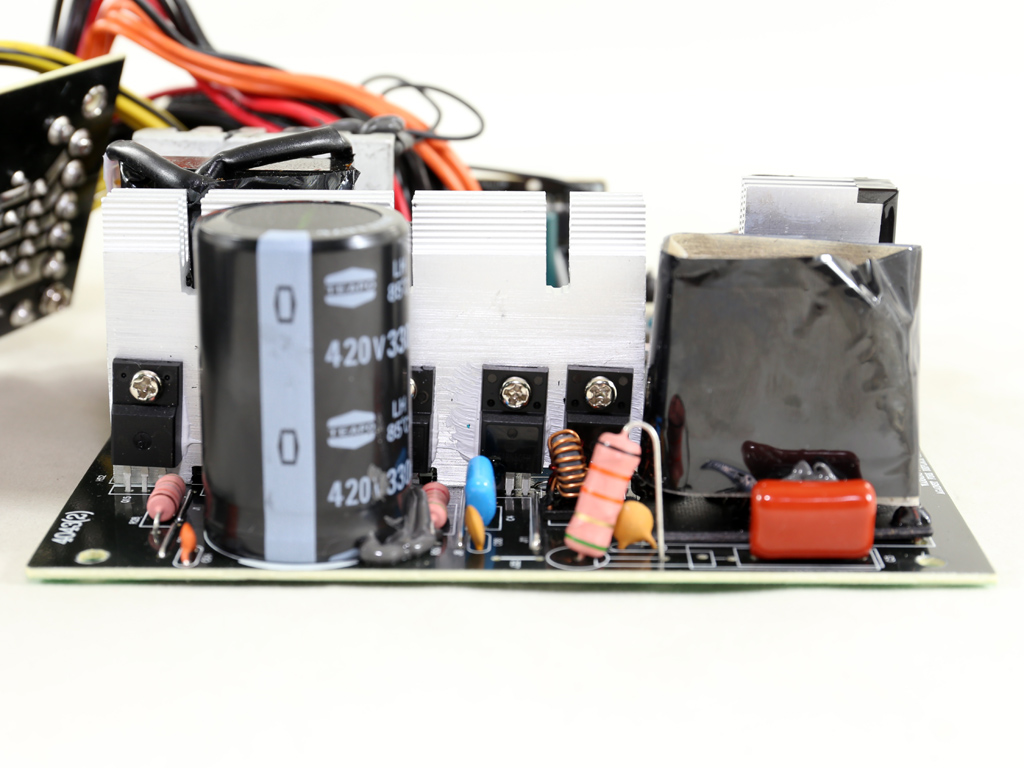





The APFC converter uses two JCS18N50FH FETs and an STMicroelectronics STTH8R06FP boost diode. The bulk cap is provided by Teapo, and it is only only rated at 85 °C. Most manufacturers use 105 °C caps in this section, even in budget PSUs. The combo PFC/PWM controller is an FSP IC with model number FSP6600. We first encountered this IC several years ago and FSP still hasn't released any information about it.
Get Tom's Hardware's best news and in-depth reviews, straight to your inbox.


There are two primary switching FETs. The main one is a Infineon SPA11N80C3, while the auxiliary (reset) FET is a CEP03N8. Though it has certain benefits, an ACRF platform generally cannot match the performance of other topologies, especially when it comes to transient response scenarios. On the primary heat sink, we also found a CEF02N7G FET that's most likely used by the 5VSB circuit.
According to be quiet!, the main and 5VSB transformers are glued in place to mitigate any possible vibrations that could lead to annoying coil whine. Indeed, we tried to mess with them and they wouldn't budge.






The two FETs that regulate the +12V rail are installed on a small heat sink, which is blocked by the main transformer. be quiet! boasts about its independent regulation, but we only spotted two filtering coils on the secondary side, so we doubt that's entirely true. The large coil is used by the +12V and 5V rails, meaning that they're bonded together, while the small one is used by 3.3V. If all rails were independently regulated then we'd see three coils. Our test results will prove our theory.



The minor rails are handled by four Infineon IPD060N03L G FETs installed on the solder side of the main PCB. Their PWM controller is most likely an FSP6601.
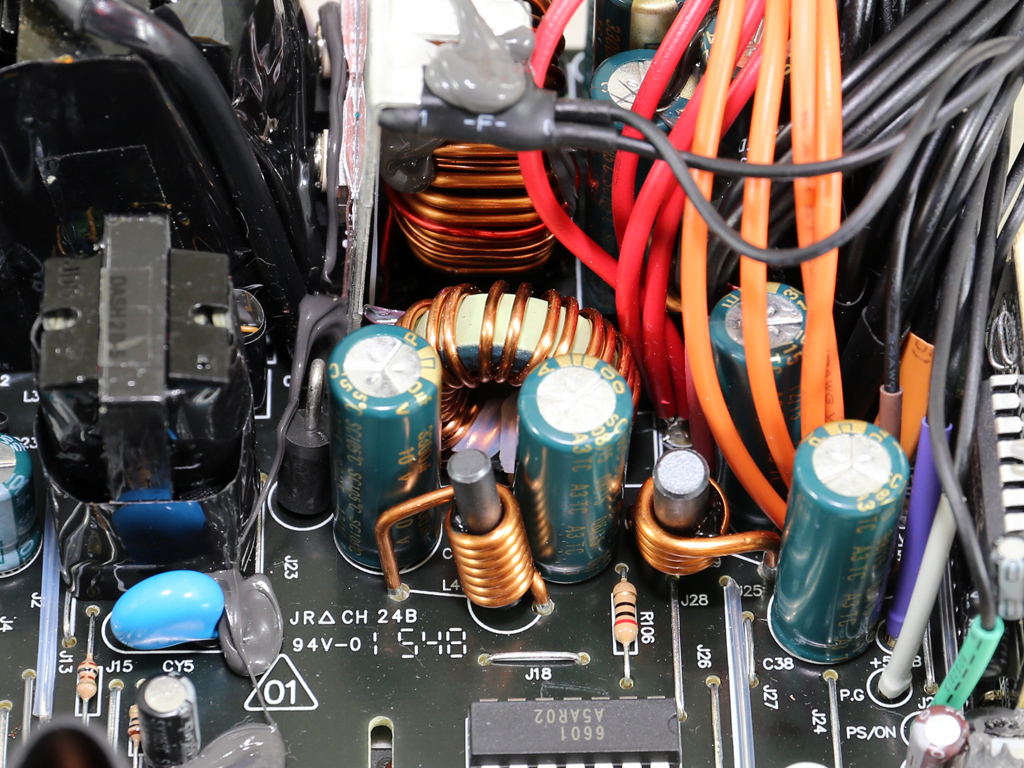
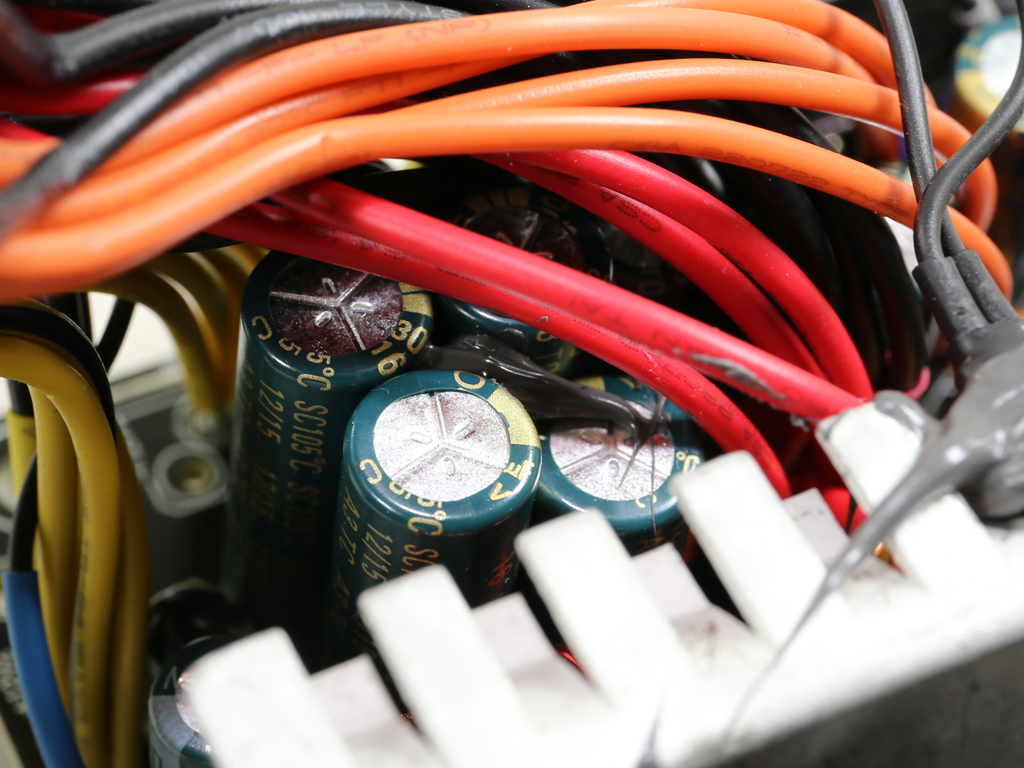
The electrolytic filtering caps are provided by Teapo; their rated life is either 2000 or 3000 hours, depending on size. Larger electrolytic caps last longer than smaller ones in the same series because they're able to dissipate heat faster thanks to larger dimensions.


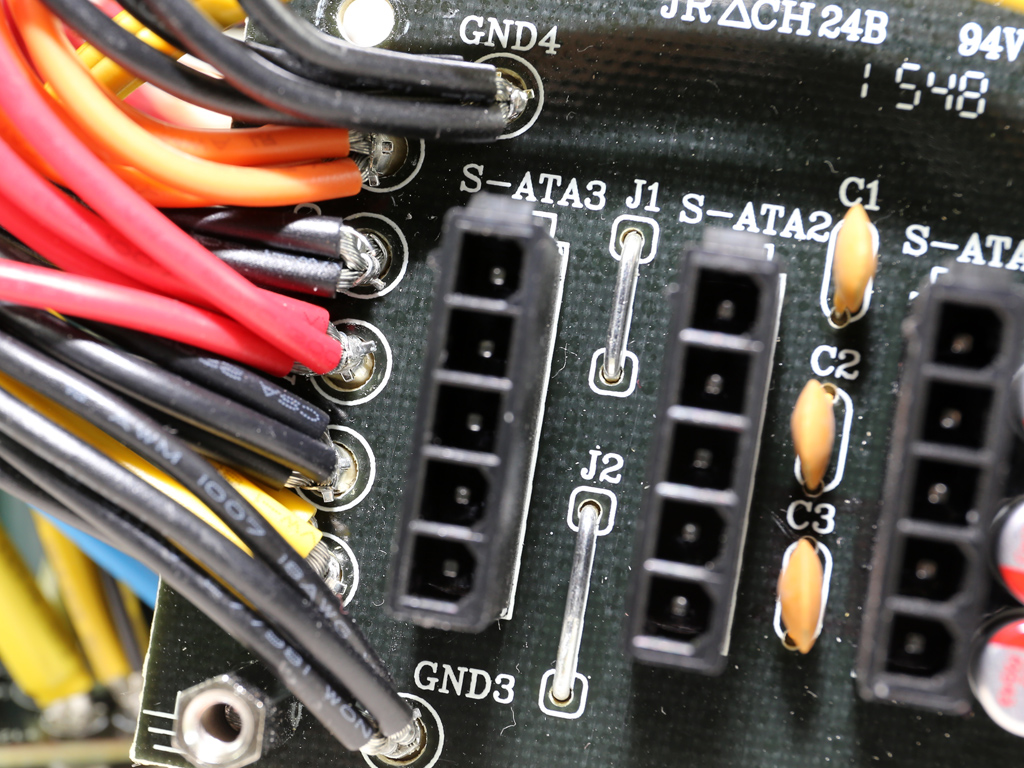
On the front side of the modular board we find several polymer CapXon caps, along with some ceramic ones that provide extra ripple filtering to the DC outputs.


The supervisor IC is a Weltrend WT7527, which is installed on a vertical PCB on the secondary side. This specific IC includes all necessary protections except over-temperature protection. That's probably implemented through an external circuit.
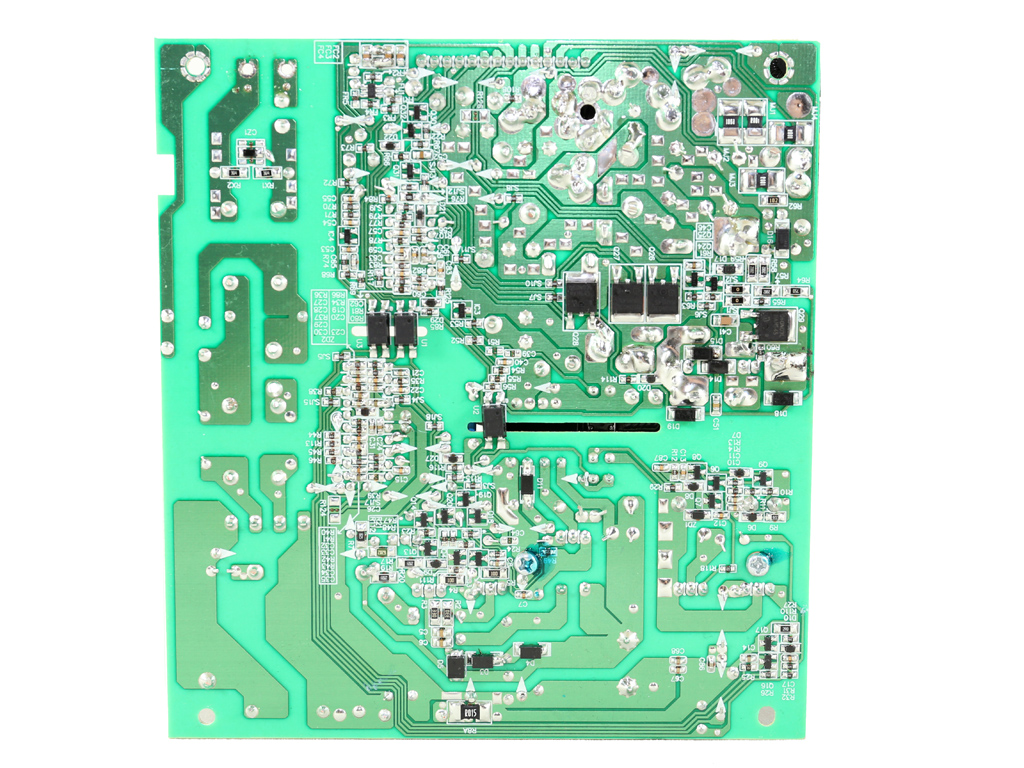


We're not impressed with this PSU's soldering quality. And to make matters worse, we noticed several long component leads that are dangerously close to other parts of the circuit.
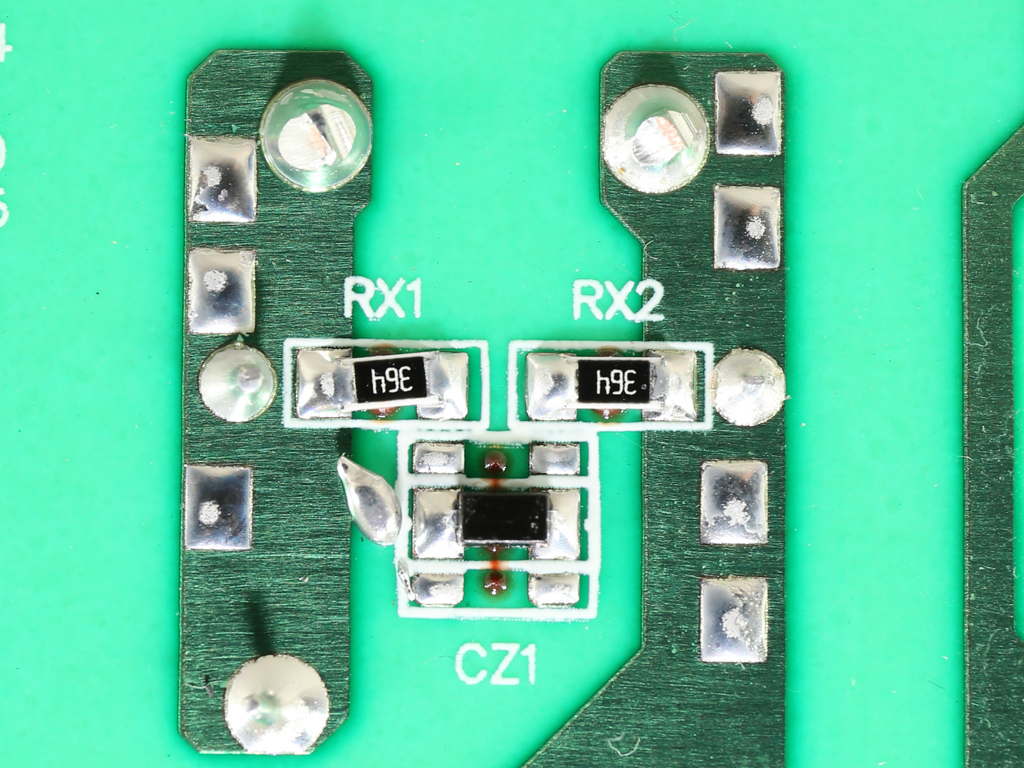








Here are some close shots of the mainboard's rear side showing the long leads of some components.


The fan is provided by be quiet! and its model number is QF1-12025-MS (120mm, 12V, 0.3A, 52 CFM, 1800 RPM). According to our sources, it uses a sleeve bearing and, thanks to a super relaxed fan profile, it should be inaudible under normal operating conditions.
Current page: A Look Inside And Component Analysis
Prev Page Packaging, Contents, Exterior And Cabling Next Page Load Regulation, Hold-Up Time And Inrush Current
Aris Mpitziopoulos is a contributing editor at Tom's Hardware, covering PSUs.
-
turkey3_scratch Really poor unit. For one thing, the crossload performance is poor. Sleeve bearing fan with less reliability. 85C primary capacitor. Once again, another failed 3.3V transient response. Very high inrush current. Also, near worst of all, 140+mv of ripple on the 12V rail in CL2. Just really bad. And CL2 is a realistic scenario these days because those 3.3V and 5V rails don't do much anyway. FSP's soldering is clearly not the same as the nice soldering on their high end units.Reply
But my largest complaint would have to be voltage regulation (line regulation) under different load scenarios on page 6. -
4745454b 85C main cap doesn't bother me that much. It should get airflow from the fan so unless the fan dies (and if it does 105C cap isn't going to help much.) or it gets clogged with dust you should be ok. As for the CL test what do you expect? It's a group regulated design so that's going to happen. It's like buying a super duty truck and then complaining you don't get 30MPG in town. What I find more bothersome is they can't seem to sell you what they claim on the box. If it's not C6 or C7 ready and not a group reg design, why claim so? I wonder if they shipped the wrong unit?Reply -
powernod Outstanding review by Aris as always! :)Reply
If only the PSU itself was outstanding as well:ouch:
-
basroil Looks like FSP is still mostly a second tier manufacture with those transient response and inrush... does it really hurt that much to put a shuntable thermistor like Seasonic and SuperFlower units have?Reply
For less than $10 more you can usually find excellent Seasonic and SuperFlower Leadex Gold units, which makes it really hard to say this PSU is anything more than "meh" -
Aris_Mp actually I am worried about the bulk cap, because 85C means that it has 4x times lower lifetime than a 105C cap.Reply -
turkey3_scratch Reply17839248 said:85C main cap doesn't bother me that much. It should get airflow from the fan so unless the fan dies (and if it does 105C cap isn't going to help much.) or it gets clogged with dust you should be ok. As for the CL test what do you expect? It's a group regulated design so that's going to happen. It's like buying a super duty truck and then complaining you don't get 30MPG in town. What I find more bothersome is they can't seem to sell you what they claim on the box. If it's not C6 or C7 ready and not a group reg design, why claim so? I wonder if they shipped the wrong unit?
Not all group regulated designs are exactly the same way. We see in Seasonic's S12ii series a group regulated design that actually crossloads very well. This seems to be one of the worst on the ladder.
@Aris: Why is Inactive PWR_OK to DC_LOSS better at a higher value? Once the PWR_OK signal is dropped, wouldn't you want the unit to shut down as quickly as possible, not prolong it? -
powernod It was already explained by Aris at his review:Reply
"The power-good signal lasts longer, so when it drops, the voltage level of the +12V rail is already below 11V."
When the pwr_ok to DC_loss is higher (*meaning that it has a positive , not negative value) that means that the motherboard will already have been shut-down. (*from what i've understand, at least) -
turkey3_scratch Not sure how the motherboard could shut down before the PWR_OK signal is dropped.Reply -
Aris_Mp the problem is that in some PSUs, PWR_OK, which informs the mainboard when it should shut down, drops after and not before the rails go our of spec. So once it drops the rails are already too low.Reply
Normally when AC is removed, the PWR_OK signal should be de-asserted at least 1ms before voltages go out of spec in order not to stress the VRMs of the mainboard and of other components (e.g. VGA, HDD, SSD, etc.).
The only way to address this issue is to have a circuit on the mainboard checking the input voltages and give the shut down order when these go out of spec. In other words to completely bypass the power_ok signal coming from the PSU. But this will cost money and after all a PSU oughts to follow ATX spec's guidelines. -
turkey3_scratch So is "DC_LOSS" considered "voltages out of spec"? I mean, there can still be DC even if voltages are out of spec. It won't be a loss of DC< just an out-of-spec voltage relative to the DC.Reply
